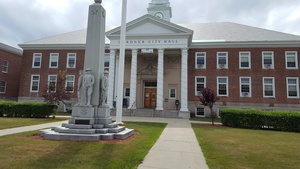Welcome to Gardner!
Gardner, Massachusetts, is known as the Chair City and “The Furniture Capital of New England” because it was once a major center for furniture manufacture. Although the factories are now closed, many of the buildings remain and have been renovated for other uses. Established in 1785 and incorporated as a city in 1923, Gardner is home to 20,228 people (2010 Census). The city covers approximately 23 square miles and is located about seventy miles from Boston in northern Worcester County.
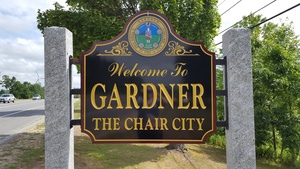 Above: Welcome sign on Green Street Below: City Hall Photos: Z. Katz
Above: Welcome sign on Green Street Below: City Hall Photos: Z. Katz
History
The City of Gardner was named after Colonel Thomas Gardner, a soldier and political figure in colonial America. Born into a prominent family, Gardner was first elected to office in 1769 in the city of Cambridge, just outside Boston. He served as Selectman and Representative to the General Court of 1769. He was considered very influential. When England’s King George dissolved the General Court, Gardner became very vocal about resistance to the crown. Gardner had a reputation as a military expert and was chosen to be a colonel in late 1774. His regiment was formed of men from Boston and neighboring towns, including present day Arlington, Malden, Medford, Newton, Waltham and Watertown. Gardner’s regiment fought at the Battle of Bunker Hill, where Gardner was mortally wounded on July 3, 17751. The City of Gardner is one of several places in Massachusetts that honors his name.
When first settled, Gardner was primarily a farming community. In 1805, a man named James Comee began making chairs by hand in his house on Pearl Street, which still stands today. Comee hired and trained several apprentices, some of whom later went into business for themselves building chairs2. In 1836, five Heywood brothers – Levi, Walter, Seth, Benjamin, and William – began making chairs in a Gardner barn. Chairs were built by hand, although later Levi invented and patented a chair-making machine that revolutionized production3. Levi eventually moved his company to the shores of Gardner’s Crystal Lake, where the furniture factory continued production until its doors closed in 1979. The factory complex, still standing at 206 Central Street, was named to the National Register of Historic Places in 1983. The buildings have been renovated for living spaces that include condominiums and apartments. Many buildings in Gardner are named after the Heywood family, including the city’s library and hospital. A large chair stands in front of the Helen Mae Sauter School as a reminder of Gardner’s history as a furniture-making giant. The chair is also captured in architecture, as it is part of the façade of the former Levi Heywood Memorial Library Building, completed in 1886. The building, which is listed on the National Register of Historic Places, has been home to the Gardner Museum since 1978. The Museum has a permanent collection of Gardner artifacts and also hosts a variety of special exhibitions throughout the year.
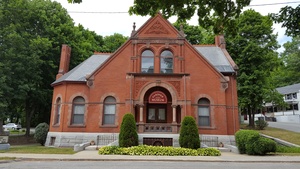 The facade of the Gardner Museum was designed to look like a giant chair. The building, which once housed the Heywood Memorial Library, is listed on the National Register of Historic Places.
The facade of the Gardner Museum was designed to look like a giant chair. The building, which once housed the Heywood Memorial Library, is listed on the National Register of Historic Places.
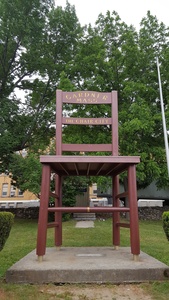 The oversized chair at 130 Elm Street celebrates Gardner's fame as "The Chair City."
The oversized chair at 130 Elm Street celebrates Gardner's fame as "The Chair City." 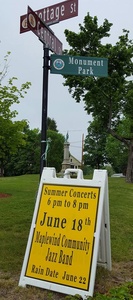 Monument Park, near downtown, is the site of a summer concert series that is free and open to the public from June to mid-September.
Monument Park, near downtown, is the site of a summer concert series that is free and open to the public from June to mid-September.
What to See and Do in Gardner
<div> Visitors to Gardner will not go hungry. There are a variety of restaurants in the city and all are moderately priced. For a slice of New England history, people in search of American fare for breakfast and lunch can eat at the Blue Moon Diner. Although an addition has been built on the back, the Diner is an original Worcester dining car that has been kept intact to retain its early 20th century charm. It is one of several diners in town but the only one built in an old-fashioned dining car. One of the most popular establishments in Gardner is The Ale House, downtown on Parker Street. The Ale House is a microbrewery and restaurant, with beer and food menus that change seasonally. The Ale House has live music almost every night of the week and, during the summer and early fall, hosts several block parties in Gardner’s downtown business district.</div>
People who enjoy the outdoors can relax at Gardner’s Dunn State Park. Covering 130 acres, Dunn has a 20-acre pond that can be used for fishing, swimming, and non-motorized boats. There are walking trails that are also used for cross-country skiing in the winter4. The park is open year-round and closes daily at dusk. Gardner has several other parks residents and visitors can enjoy. A shorter walking trail follows the City’s reservoir between Veterans’ Memorial Skating Rink and the municipal golf course on Eaton Street. There are four playgrounds – Bickford, Jackson, Oliva Case, and Pulaski. Greenwood Memorial Outdoor Pool and Spray Park is located on Park Street. The century-old indoor pool is currently closed pending completion of renovations.
Gardner has a local-access television station (GETV) that features programming on the governmental, educational, and public activities of the city5. The local radio station, WGAW, is an AM station with an all-talk format. Gardner is home to Mount Wachusett Community College established in 1963 and currently serving more than 12,000 credit and noncredit students annually. The college’s main campus boasts 269 acres, with satellite campuses located in Devens, Fitchburg, and Leominster, Massachusetts. The giant wind turbines adjacent to the campus can be seen for miles. The $9 million project, which was completed in 2011, generates 100% of the college’s annual electricity needs and returns power back to the grid6. The college is home to a number of community theater productions staged from September to May and also hosts a number of programs of community interest throughout the calendar year.
Notes
1 Bonislawski, Michael. “Gardner’s Regiment.” The Charlestown Militia Company, Inc. N.d.
Web. 27 June 2016.
2 Herrick, William Dodge. History of the town of Gardner, Worcester County, Mass.: from the
incorporation, June 27, 1785, to the present time (1878). Cornell University Archive. N.d.
Web. 28 June 2016.
3 “About Heywood Wakefield Furniture.” Woody’s Antiques. 2008. Web. 28 June 2016.
4 “Dunn State Park.” The Official Website of the Executive Office of Energy and Environmental
Affairs, Commonwealth of Massachusetts. 2016. Web. 28 June 2016.
5 “Gardner Educational TV.” www.gardner-ma.gov. 2016. Web. 28 June 2016.
6 “Wind.” Mount Wachusett Community College. 2016. Web. 28 June 2016.

